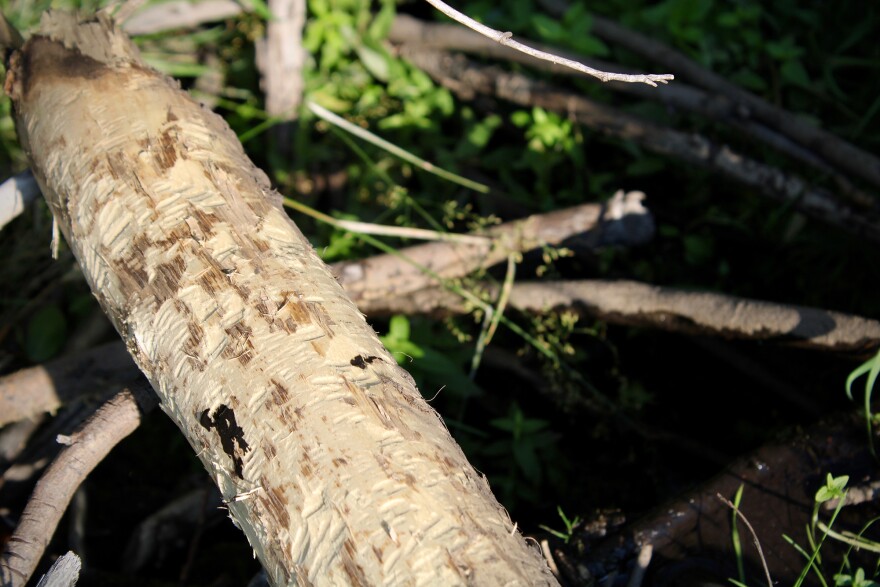Deep in the Cameron Peak burn scar, nestled among charred hills, there鈥檚 an oasis of green 鈥� an idyllic patch of trickling streams that wind through a lush grass field. Apart from a few scorched branches on the periphery, it鈥檚 hard to tell that this particular spot was in the middle of Colorado鈥檚 largest-ever wildfire just a year ago.
This wetland was spared thanks to the work of beavers.
The mammals, quite famously, dam up streams to make ponds and a sprawling network of channels. Beavers are clumsy on land, but talented swimmers; so the web of pools and canals lets them find safety anywhere within the meadow.
On a recent visit to that patch of preserved land in Poudre Canyon, ecohydrologist Emily Fairfax emphasized the size of the beavers鈥� canal network.
鈥淥h my gosh, I can鈥檛 even count them,鈥� she said. 鈥淚t鈥檚 a lot. There鈥檚 at least 10 ponds up here that are large enough to see in satellite images. And then between all those ponds is just an absolute spiderweb of canals, many of which are too small for me to see until I鈥檓 here on the ground.鈥�

The very infrastructure that gives beavers safety from predators also helps shield them from wildfire. Their work saturates the ground, creating an abnormally wet patch in the middle of an otherwise dry area. Dams allow the water to pool, and the channels spread it out over a wide swath of valley floor.
Fairfax researches how beavers re-shape the landscapes where they live. Across the West, she鈥檚 seen beaver-created wetlands survive wildfires.
鈥淲hen you鈥檙e at this beaver complex,鈥� she said, 鈥渋t never stops being green. Everything else in the landscape 鈥� the hill slopes on either side, they both charred. They lost all their vegetation during this fire. But this spot, it did not. These plants were here last year and they鈥檙e still here today.鈥�

Fairfax stands in the middle of a vibrant meadow, with golden-green grass up to her knees. She points to a row of trees about 100 feet away, where the trunks have clearly been singed, but brown needles still cling to branches 鈥� a sign of 鈥渕oderately intense鈥� burning. Just another 100 feet past that, another row of trees has been scorched completely black and free of needles 鈥� a telltale indicator of 鈥渉igh intensity鈥� burning.
That gradient, Fairfax said, shows just how effectively the wet beaver meadow held back the fire. These saturated wetlands also serve as a kind of reservoir, slowing down the release of mountain runoff on its way to the places where humans divert and collect it.
鈥淚t's mimicking this critical function that used to be pervasive in these riverscapes,鈥� said Joe Wheaton, a fluvial geomorphologist at Utah State University. 鈥淎nd is that a similar function to what snowpack does or the inefficient movement of water and that leads to healthier riverscapes.鈥�
Just like snow, beaver wetlands hold water for gradual release. That will likely get more important as climate change drives warmer temperatures and less snowfall, making high-mountain water storage even more valuable.

The wetland storage system can be bigger than it looks, since more than 80% of the water in beaver complexes is actually underground. But in the grand scheme of things, Wheaton said those systems don鈥檛 store that much water.
鈥淏eaver are not going to be the miracle answer,鈥� he said. 鈥淵ou鈥檙e not going to create more water at that sort of scale.鈥�
While it won鈥檛 make a difference for water managers looking at water from a basin-wide perspective, people are noticing significant changes on a small scale 鈥� like when an upstream beaver dam lets a rancher get water a bit longer into the season during a drought year.

That isn鈥檛 lost on humans, who have tried to reap the benefits of beaver wetlands by creating their own. A budding world of 鈥渂eaver dam analogs鈥� has seen the strategic creation of human-built dams in an effort to help slow the release of water.
Projects across the West have seen some success, but largely have not been as effective as the real thing.
鈥淭he beaver complex and the beaver wetland is so much more than the dam,鈥� Fairfax said. 鈥淚t鈥檚 the channels, it鈥檚 the digging, it鈥檚 the chewing, it鈥檚 the constantly changing the landscape, the dynamics, the flexibility.鈥�
Beavers have millions of years of practice repairing dams and shaping rivers, and that makes them capable water managers.
Fairfax did see a beaver complex serve as a fire break one time in Colorado, but she said it鈥檒l take far more research before we can figure out how effective they are when it comes to slowing down wildfires on a large scale. But for now, these areas are surviving as oases of green in big fires all across the West.
This story is part of ongoing coverage of the Colorado River basin, produced by KUNC in northern Colorado, and supported by the Walton Family Foundation. KUNC is solely responsible for its editorial content.






